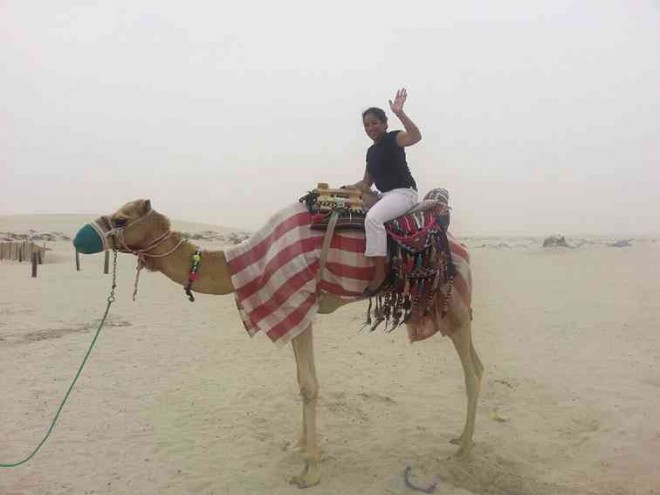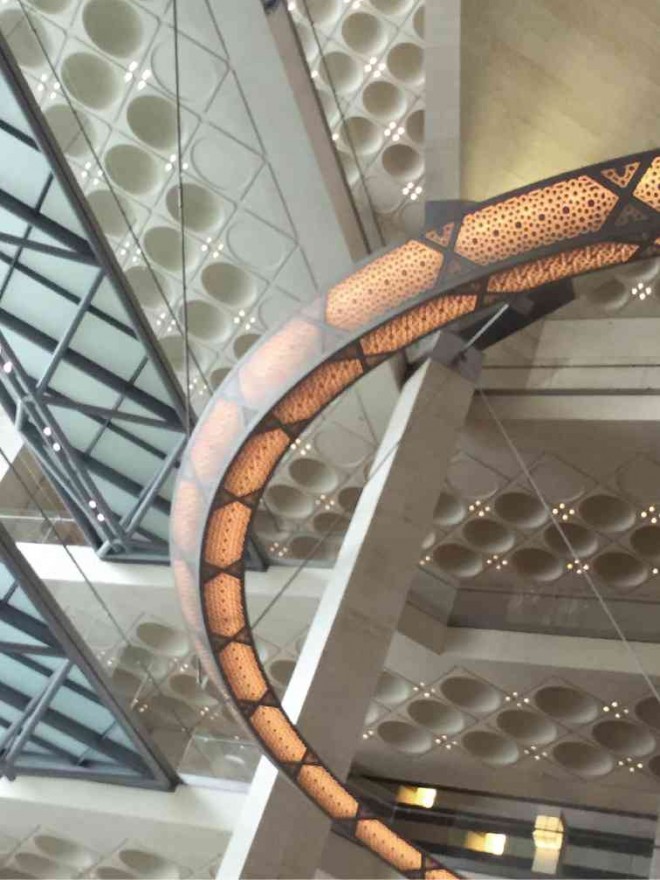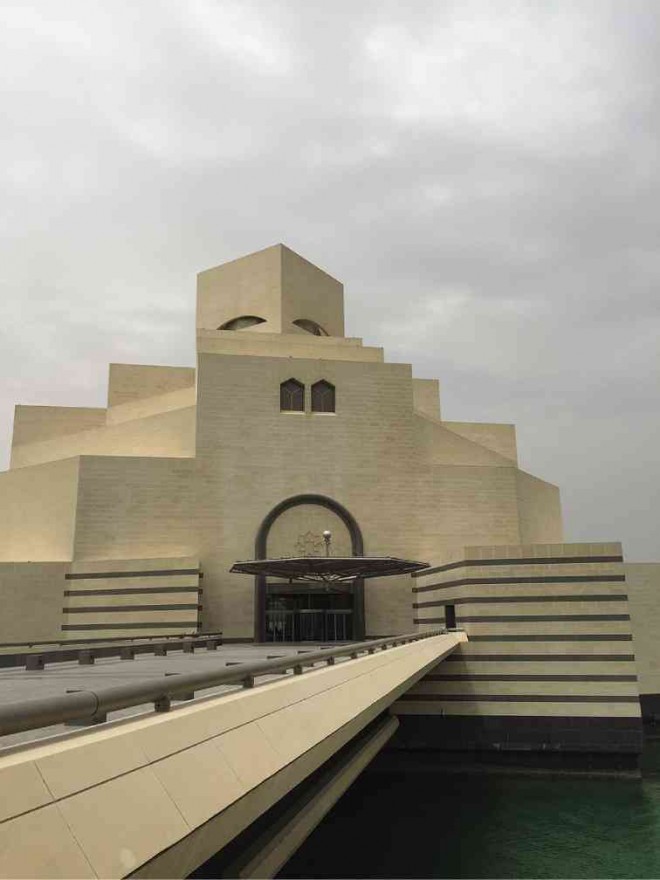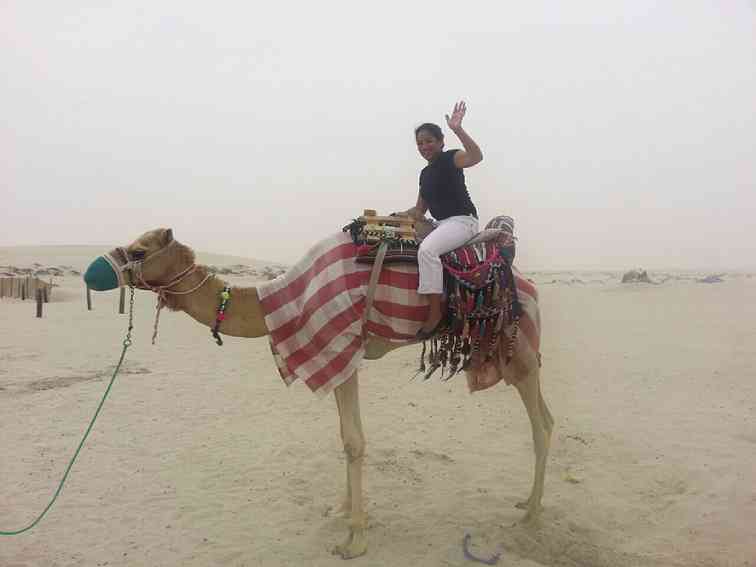
Qatar has always been just an airport stop for me, connecting to and from the usual European destinations. But after having the opportunity to spend a few days there, I realize now that it is a worthwhile destination not just for its amazing food, but also for its culture and arts.
Over the years, I have enjoyed the food on board Qatar Airways and at the Doha airport lounge. The Arabic delights have always made me wonder what the country’s food might be like.
On my recent trip, I finally confirmed that Qatar’s cuisine and dining scene are indeed vibrant and multi-faceted.
Soon after landing, we were led to a VIP arrival lounge at the new and amazing Hamad International Airport. There was a nicely laid-out array of sandwiches and salad tasting, but what I was most happy to find was the hummus. It was a delicious preview of things to come!
Arriving in the Sharq Village and Spa Hotel, operated by the The Ritz Carlton Group, we were whisked to our rooms. But seeing the oasis-like poolside and the long stretch of white sand beach that lined the resort, I took a quick walk and soaked my feet in the cool blue waters.
Our first dinner at the hotel’s Al Liwan restaurant introduced us to a large spread of mezze that included not only the usual tabbouleh, moutabal and hummus, but new discoveries like a variety of labneh, mouhamarah, spiced cheeses and more.
The perfectly grilled kebabs of chicken, lamb and beef, and the most flavorful lamb chops, all expertly done by the chefs in an open kitchen, definitely satiated my appetite. Watching the chefs in action was wonderful, with the amazing aroma wafting through the entire dining room.
The surprise of the evening was the desserts. The oum ali, a creamy Arabic bread pudding, and the mouhalabiya, a milk pudding with pistachios, honey and fruit purée, were balanced in sweetness.
Our guide Yasmin said they take their food seriously in Qatar. This buffet spread was indeed evidence. Our meal was a feast fit for a princess, made more real as I retired into my elegant Arabian-themed suite.

Narrow alleys
The next day started with a tour of the Souq Waqif, also known as “The Standing Market,” in the district of Mushayrib in the center of Doha.
Narrow alleys were crowded with colorful shops selling garments and fabric, antiques, crafts, cookware, sweets, spices, nuts and dried fruit. It is home to many restaurants, cafés, shisha lounges, and the famed Falcon Hospital, a care center for their national bird, the falcon.
I took home rose petal and hibiscus teas, and the longest threads of saffron I have ever seen. It was an eye-opening introduction to the lifestyle and culture of Qatar.
From the rustic surroundings of the souk, we were transported to the new Museum of Islamic Art, designed by I.M. Pei. The ultra-modern structure was quite a contrast to the market we just came from.
It is the first of its kind in the Arab states of the Persian Gulf to have an extensive collection of Islamic art from various cultures. Although it is very sleek and modern, Islamic architectural details are still very evident.
As impressive as the art is the Philippe Starck-designed fine dining restaurant of Alain Ducasse on the top floor. It is called IDAM, and it gives an Arabic twist to French-Mediterranean cuisine. It was such a pity not to have had a chance to enjoy his signature dishes, but this only means another visit is due soon.
Even the snacks at the ground floor café such as the sleek, slim sandwiches, the hip juice bottles, and the clearly chilled soups bore the Ducasse trademark and promised nothing but good food.
Lunch found us back at Sharq’s Parisa, the first Persian restaurant in a luxury Doha hotel. Housed on the third floor of a seaside pavilion, it offered stunning views of Doha Bay.
We were met by a display of spices that gives off the distinct and natural aroma of the cuisine. Because it is Persian, vegetables and fruits like aubergines and pomegranates are given as much importance as the meats.
Always game to try new stuff, I volunteered to make the flatbread in the oven, slapping it on the sides of the oven with a puffed cloth pillow. These breads were perfect with the cold starter assortment of Salad-e Shirazi (cucumber, onion, tomato in lime dressing); Mast-o Khiar (yogurt, cucumber, walnuts and raisins); and the Zeytoon Parvarde (green olives pomegranate syrup, and walnuts).
The grilled meat or “kabab” selection came on small tabletop warmers—my favorite Koobide (ground lamb), as well as Kabab Barg (beef fillets), Kabab Mahi (Hammour fish fillet) and Joojie Kabab (chicken breasts), all seasoned with saffron, onion and a hint of lemon, were perfectly executed.
They all went well with the trio of rice and stews, served nicely in custom-made copper pots with lids. Of the lot, my favorites were the Khoresht-e Ghorme Sabzi, made of spinach, lamb and kidney bean, and Khoresht-e Fesenjan, made with chicken breast, pomegranate and walnuts.

Middle Eastern village
The trek to the Six Senses Spa in the resort wasn’t enough to walk off our hefty lunch, but the spa experience was the ultimate. Encased in a structure evoking a traditional Qatari setting, it made one feel like being in an old Middle Eastern village.
It was the perfect way to cap off our stay at the Sharq, as we got to know the local color and lifestyle.
That same night, we moved to The Ritz-Carlton Hotel, a grander structure of nearly 50 floors, in the West Bay Lagoon district on the other end of the cornice.
Arriving just in time for dinner, we were escorted to the hotel’s French restaurant, La Mer, on the top floor. We enjoyed the amazing sight of the Doha skyline, along with delectable dishes like scallops seasoned with dukkah, raw cauliflower couscous, yogurt, roasted almonds and hibiscus.
The Hamachi Tartar, composed of fresh yellowfin tuna, yuzu foam, cucumber, apple and salmon eggs, was refreshing, while the Foie Gras Torchon with cocoa, apricot and pistachio granola was quite memorable.
I also thoroughly loved my Tea-Smoked Duck Breast, duck leg croquette, cranberry, parnsnip pureé, and floral tea reduction as it proved to be a play of flavors and textures.
The group shared three desserts—the Chocolate World, a dark chocolate composition, foie gras crème brûlée, and poached pears—and they were a great way to end this repast.
The following day was another adventure—not the eating kind, but a worthwhile trip to the sand dunes on the Qatar desert safari. We boarded a white land cruiser, with our driver who, we were told, spoke no English, strapped our seatbelts, and rode off at top speed.
The cruiser sped up and down, much like a roller coaster on a sea of sand, dipping sideways, almost to the point of tipping over.
We felt almost hostaged—we could not even yell out for him to slow down, since we thought he would not understand us anyway.
After nearly half an hour of this dizzying, stomach-turning, gut-wrenching ride, finally, the horizon revealed a beautiful coast!
As we got out to catch our breath and get some air, a flock of birds flew over us, to which our driver softly said, “Would you like some juice?” We all broke out in laughter and relief.
After enjoying the sand and sea, our group drove off to the camp where tents were pitched and lined with red carpets and cushions, ready to welcome us with some tummy-settling tea and the much-awaited photo opportunity with camels.
We headed back to Doha on a bus—this time on a much smoother and calmer ride.
We dropped by a bookstore, in search of cookbooks on Arabic cuisine. After that detour, we drove through West Bay, past the site of the still under construction National Museum of Qatar by architect Jean Nouvel, inspired by flowing sand dunes, passing through one of the city’s most developed districts, en route to Katara Cultural Village.

Coastal development
A strip along the coast with an interesting selection of restaurants, art galleries, and a marble amphitheater, this coastal development seamlessly marries the modern and the traditional. Large sculptures pepper the open spaces, benches line the area, and beautiful tents and beach umbrellas are scattered around for people who want to enjoy the beach.
It was in this same area that I had my most memorable meal of the trip. After walking past Sukar Pasha, a Turkish restaurant roasting baby lamb on a spit, the group opted to do lunch at Mamig, a cozy restaurant specializing in Lebanese and Armenian cuisine. They served us a standout meal composed of fattoush, a mixed salad with fried bread and hummus topped with basterma; Rekakat with Cheese, cheese rolled in thin dough; and Lebanese Kebbeh, stuffed with minced meat and pine nuts, among many others.
The most memorable dishes were the chicken liver cooked with pomegranate seeds and molasses, and the Lebanese Sambousek, stuffed dough with minced meat and pine nuts, along with the superb grilled chicken and lamb chop plates.
We then walked off this amazing lunch and proceeded to The Pearl, the most luxurious outdoor area of Qatar that has rows of high-rise condominiums with luxury brand shopping and dining venues to complement this upscale residential community.

Kempinski
We spent our last evening in the newest grand hotel in Doha, the Marsa Malaz Kempinski located at The Pearl Qatar. The imposing cone-shaped chandelier by its entry is made of blown glass, with pieces made to resemble oyster shells. A sculpture of a pomegranate stands dead center at the lobby, reminding guests of one of the most unique ingredients in their cuisine.
A 16-meter bronze horse by sculptor Ahmed Bharani also stands tall in the hotel’s verandah.
The rooms are equally stunning as they celebrate Arabic design with a modern vibe. But perhaps the most remarkable thing about the Kempinski is the range of restaurants, all of which are uniquely designed, from the edgy brick-lined Spanish El Faro, to the Italian Antica Pesa that reworks traditional Roman recipes using local organic produce, and the celebrated Al Sufra, where we enjoyed dinner. It is an elegant Arabic restaurant that blends flavors from Syria, Lebanon, Cyprus, Jordan and Palestine and takes the cuisine to new heights.
From a smoking bowl of moutabal, to three kinds of hummus, and a large repertoire of slow-cooked rice and meat dishes, the stellar dishes blew us away, as did the amazing interiors.
The kadaif dessert with double cream was the ultimate way to end the celebration.
We spent our last morning at the Legacy Pavilion, viewing the same spectacular Sensurround presentation unveiled before the FIFA board that won Qatar the chance to host the 2022 World Cup. It projects what Qatar will be like by 2022, with a light railway system spread out all over the city, and infrastructure that will make it the only World Cup destination where all the stadiums for the entire competition will be in one city.
Judging from the fast pace of growth we saw the four days we were there, there is no doubt that it will be a reality.
The skyline of Doha—with its gleaming skyscrapers that include Jean Nouvel’s unique pickle-like masterpiece, the Doha Tower, or the Burj Doha—is proof that the growth will continue.
Perhaps when I return, I will get that table at IDAM, and see the new National Museum of Qatar, finally with open doors and sharing its treasures with the world.
Visit Qatar and enjoy its culture and cuisine; www.qatartourism.gov.qa.
Fly via Qatar Airways, which is one of the fastest growing airlines in the world. Flights leave from Manila and Clark straight to Doha and connecting to 145 other destinations; www.qatarairways.com.ph for more details.
The author is a leading culinary expert in the country who conceptualizes and runs a restaurant chain and food catering. She was also the mover behind the recently successful Madrid Fusion Manila.









































